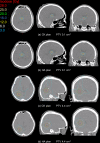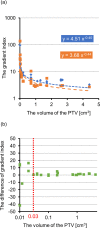Dosimetric performance of two linear accelerator-based radiosurgery systems to treat single and multiplebrain metastases
- PMID: 31188018
- PMCID: PMC6724620
- DOI: 10.1259/bjr.20190004
Dosimetric performance of two linear accelerator-based radiosurgery systems to treat single and multiplebrain metastases
Abstract
Objective: To evaluate and compare the dosimetric plan quality for noncoplanar volumetric arc therapy of single and multiple brain metastases using the linear accelerator-based radiosurgery system HyperArc and a robotic radiosurgery system.
Methods: 31 tumors from 24 patients were treated by stereotactic radiosurgery using the CyberKnife system. CT images, structure sets, and dose files were transferred to the Eclipse treatment planning system for the HyperArc system. Dosimetric parameters for both plans were compared. The beam-on time was calculated from the total monitor unit and dose rate.
Results: For normal brain tissue, the received volume doses were significantly lower for HyperArc than for CyberKnife_G4 and strongly correlated with the planning target volume (PTV) for cases of single brain metastasis. In addition, the difference in volume dose between CyberKnife_G4 and HyperArc was proportional to the PTV. For multiple brain metastases, no significant difference was observed between the two stereotactic radiosurgery systems, except for high-dose region in the normal tissue. In low dose for brain minus PTV, when the maximum distance among each target was above 8.0 cm, HyperArc delivered higher dose than CyberKnife_G4. The mean ± SDs for the beam-on time were 15.8 ± 5.3 and 5.6 ± 0.8 min for CyberKnife_G4 and HyperArc, respectively (p < .01).
Conclusion: HyperArc is best suited for larger targets in single brain metastasis and for smaller inter tumor tumor distances in multiple brain metastases.
Advances in knowledge: The performance of HyperArc in comparison with CyberKnife_G4 was depended on defined margin and tumor distances.
Figures






References
-
- Gevaert T , Levivier M , Lacornerie T , Verellen D , Engels B , Reynaert N , et al. . Dosimetric comparison of different treatment modalities for stereotactic radiosurgery of arteriovenous malformations and acoustic neuromas . Radiother Oncol 2013. ; 106 : 192 – 7 . doi: 10.1016/j.radonc.2012.07.002 - DOI - PubMed
MeSH terms
LinkOut - more resources
Full Text Sources
Medical

